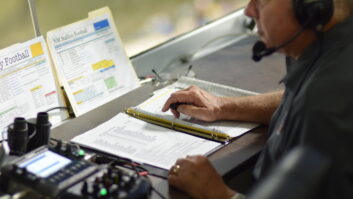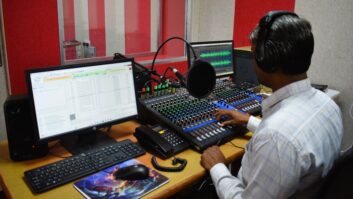The chairman of AsiaSpace and former secretary general of the ITU comments on the direction of global digital services
In the April 11 issue of Radio World, I read the guest commentary “It’s Radio, Jim, But Not as We Know It” by Quentin Howard, which provided some interesting generic insights but fell away on some critical elements.
We all know a major factor in the success of DAB will be the achievement of effective cost reductions in digital receivers and terminals. So with the years of availability of the Eureka-147 specifications, it must be disappointing that the mass production encouraged by your guest commentator has not come about.
System development
The sentiments can be appreciated for I am well aware of the huge efforts that have gone into its development as a specification standard over the past decade or more.
But it is the gratuitous advice that has been given to countries like Australia – “DRM would be ideal for the Outback and Eureka for its metropolitan cities” – that needs correction.
First, such a suggestion flies in the face of a long-standing objective of the search for technologies to enable the prospect of universal service throughout the nation – this means to Australians living on the continent and also the associated Australian small islands.
In the current era of human, economic, political and related rights, many governments are required to address the reach of new technologies and services to the underserved rural and remote areas of their countries.
Shortfalls of the past, taken for granted on economic considerations, are no longer valid for satisfying the aspirations of those rural and remote communities for whom quality radio and associated services are a vital yearning and need.
What is at issue now is the strength of national values and the search for solutions to provide reasonable equality of access.
Indeed, in regards to Australia, there is a parliamentary inquiry into the radio industry over services to the non-metropolitan areas.
(click thumbnail)Fig. 1: Hybrid Satellite/Terrestrial Concept
Common user sharing
As to Digital Radio Mondiale (DRM) technology developments, there must be major policy, budgetary and operational cost issues related to available HF spectrum and parallel running, having moved off the earlier intended change to single sideband, which could have been accommodated with somewhat easier transition arrangements.
In 1993, following WARC 92, Australia notified the ITU of a proposed L-band DAB satellite system at 151.5 degrees east with particular spot beams within the nation.
But in 1999, the notification was modified to provide for a potential system of three independent subregional beams, each with prime coverage, as follows: A, Australia and its small islands, Papua New Guinea and East Timor; B, the South Pacific; and C, parts of Asia (mainly the ASEAN area).
The common user-sharing opportunities of a satellite capability for direct DAB transmission to personal and portable receivers may well enable a mix of complementary, low-cost terrestrial single-frequency networking.
At the same time, it may well provide both efficient spectrum use and the business case to widen service access beyond the simple and expensive terrestrial solutions that have been advocated by particular interests.
But there are other changes toward enhancing specifications and low-cost service opportunities.
Enhancing specifications
For example, the initial WorldSpace satellite delivery specifications (system D) have now been extended. International recognition has been given in the ITU-R process, to provide for spatial diversity (repeated “second” with a slightly delayed signal transmission) and now a modern MCM application for low-powered retransmission – now known as a hybrid satellite/terrestrial standard.
These enhancements will go into the commercialization phase in 2002.
They will facilitate service where line-of-sight may be hindered – in tunnels, under bridges and in built-up areas.
In reality, this development fits well with the intention of WARC 92 for spectrum allocation for BSS (satellite radio broadcasting and complementary terrestrial coverage).
Now let us turn to the vital question of receiver price reductions. The initial WorldSpace receivers of three years back may have come to market in the $200 to $300 range, but this has already been halved for the receivers of the original four manufacturers from Japan.
Moreover, other manufacturers are now active in China, India, Indonesia, Korea and Thailand with major price downturns to below $100.
One unit going into mass production is expected to come to market for $60, with basic features of addressability, connection to other multimedia products and desktop computers.
In another instance, there is the low-cost addition of the L-band DAB service feature to a CD multiplayer unit at minimum cost to the market, which has led to action toward the export of the product to other countries – developed and developing.
(click thumbnail)Fig. 2: Accredited WorldSpace Receivers
Affordable receivers
You will note the accent on service delivery, as well as on the comparative indications of unmatched current price levels to other digital systems. As I indicated, there is the evidence for further price reductions sooner rather than later.
Moreover, already in service is multimedia downstreaming – quality sound with graphics, image and text. This is opening up many support possibilities for agriculture, education, environment, health and tourism, and for small community traders with fixed, portable and mobile access.
Indeed multimedia and datastreaming services are already in operation through PC card accessories to receivers to desktop computers or direct via accredited versions of yagi antennas with card connector direct to desktop PCs and from both AfriStar and AsiaStar.
In July 2001, WorldSpace and its China joint-venture partner ChinaSat commissioned a new hub uplink earthstation in Beijing for uplinking to the AsiaStar northeast beam deliver DSB services in China and the neighboring areas. China has opted to use the L-band spectrum allocation for satellite DRB.
Action is well in hand for uplinking both quality radio and multimedia information services to the addressable receivers and terminals throughout China.
In summary, the WorldSpace system has been in operation for some three years and has provided quality performance beyond expectations. There has been the international recognition of the extension of the initial satellite delivery specifications for efficient and effective spectrum use with hybrid satellite/terrestrial means of delivery for fixed and mobile applications.
There have been the significant and major reductions in the consumer prices for the personal and portable receivers and terminals. Further downward reductions are in the pipeline.













